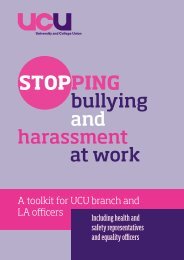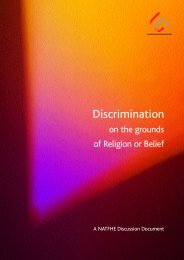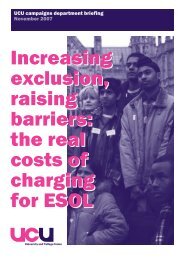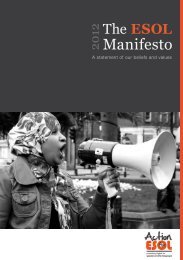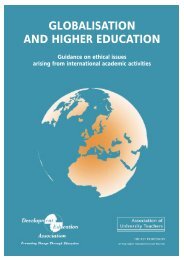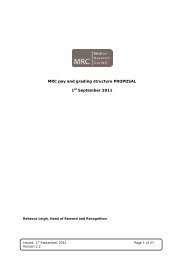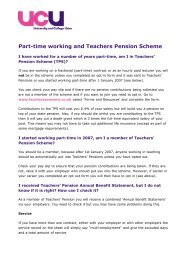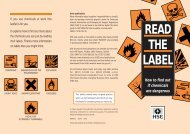zimbabwe - UCU
zimbabwe - UCU
zimbabwe - UCU
You also want an ePaper? Increase the reach of your titles
YUMPU automatically turns print PDFs into web optimized ePapers that Google loves.
AcademicFreedomInternationalStudyBURMACOLOMBIAISRAELPALESTINEZIMBABWEJames Cemmell May 2009
This paper about Zimbabwe is a chapter from alarger report looking at academic freedom in fivecountries (the others are Burma, Colombia, Israeland Palestine), which has been made available asfive individual ‘single country’ chapters for quickerdownloading and easier reading. The other fourchapters, as well as the whole report, can bedownloaded from <strong>UCU</strong>’s website at www.ucu.org.uk.Author’s biographical noteJames Cemmell (jamespearl@hotmail.com) presently works asa regulatory consultant in London, UK. His longstanding interestin internationalism in the higher education sector wasstimulated while a student at the University of Leeds. Upongraduation in 2000 he was elected as the sabbatical EducationOfficer at Leeds University Union and was subsequentlyelected as Convenor of West Yorks Area NUS. He completed afour year appointment at ESU/ESIB (European StudentUnion) to a committee concerned with emerging policy practicesand regulatory frameworks in international educa-tion.Along the way he completed an MA in International Developmentat the University of Bradford and spent a year at theUniversity of Bristol in the Graduate School of EducationCentre for Globalisation, Education and Societies where hepursued diverse interests in the GATS, Bologna and higher educationreform issues in Kosovo. When time, family and injuriespermit, James pursues interests in Shotokan Karate.James Cemmell asserts his moral right to be identified as the authorof this study.
CONTENTSForewordSally Hunt general secretary, <strong>UCU</strong> 1PrefaceFred van Leeuwen general secretary, Education International 1Introduction 3Matrix of academic freedom components 5Burma 7Annex 1 Recent human rights violations compiledby Altsean during March 2009 14Annex 2 IAU overview of the higher educationsector in Burma 2005 15Annex 3 Description of the higher education sectorfrom Yangon City Municipality 17Annex 4 Breakdown of higher educationinstitutions by sector 17References 18Colombia 19Annex 1 IAU sector description 29References 30Israel 31Annex 1 The Balfour Declaration 41Annex 2 IAU sector description 41References 43Palestine 44Annex 1 Abridged review of Palestine since 1948 55Annex 2 Electoral law reform 56Annex 3 IAU sector description 56References 57Zimbabwe 59Annex 1 AUP Zimbabwe HE sector 67Annex 2 State of the education sector in Zimbabwe:ZINASU monthly briefing paper (March 2009) 68References 69
INTRODUCTION...there is strong evidence that economic andpolitical freedoms help to reinforce one another...Similarly, social opportunities of education andhealth care, which may require public action,complement individual opportunities of economicand political participation and also help to foster ourown initiatives in overcoming our respectivedeprivations.* Amartya Sen, 1998 Nobel LaureateThis study was written over five weeks in Spring 2009 andhighlights key constraints on the availability of academicfreedom in five countries: Burma, Colombia, Israel, Palestine †and Zimbabwe. The choice of countries to be profiled waspurposeful—each provides, due to the specifics of the nationalsituation, a clear illustration of the interplay between societyand the academy’s ability to operate properly and free fromunwarranted interference.The forces exerted on the higher education (HE) sectorvary with each national setting. In each country study,demonstrable acts of resistance by the university sector tomaintain and uphold academic freedoms can be seen.Unfortunately it is also possible to provide evidence in eachnational setting of severe restrictions on academic freedomswhereby resistance has either not been effective or is not inevidence. Extreme examples include the use of paramilitaryorganisations as strike breakers in Colombia, the forciblere-education of university teachers in Burma, the conduct ofparty political violence on campus in Palestine, the absence ofjob security for many junior faculty in Israel and the summarydetention of student activists in Zimbabwe.Interdependence of freedomsThe country profiles consider that freedoms within a societyare mutually reinforcing. As a consequence, the availability ofeconomic, political, social and cultural freedoms have abearing on pedagogical and academic freedoms. The profilesconsider the national political and social situation in orderthat the debates concerning academic freedom can beconsidered in an appropriate context; as a result, each profilediffers in structure. However, the basic outline is to considerthe national situation, the trade union situation and then thehigher education sector. The cases profiled demonstrate keypolarizing elements of the national situation—such as thepresence of armed movements in Colombia and therestrictions on movement in and between the West Bank andGaza caused by Israeli actions.Trade unions, as key social actors, operate in a position ofcontest within societies. As a consequence, much can beunderstood about the availability of academic freedoms byconsidering the situation in which trade unions operate in53
INTRODUCTIONwithin the country. It is significant that in countries wherethere are severe restrictions on academic and politicalfreedoms—such as in Zimbabwe, and Colombia, nationalresistance has formulated around trade union actors.Similarly, student and academic movements have formed thevanguard of resistance in countries considered in this study,such as Burma, but also in other countries outside of thepresent study such as Serbia, South Africa and China.The role of UNESCOThe 1997 UNESCO Recommendation concerning the Statusof Higher-Education Teaching Personnel provides an importantregulatory instrument for assuring free and fair conduct ofacademic livelihoods. Appended to the Recommendation arefifty international conventions and other legislativeinstruments which, if implemented, ensure that the academycan operate in a responsible and autonomous manner.The status of the Recommendation is reviewed jointly withthe ILO through the Committee of Experts on the Applicationof the Recommendation concerning the Status of Teachers(CEART) which meets every three years—the next session willbe held this year. CEART is an influential mechanism thatprovides for national cases to be referred for additional studyand has previously considered representations made withrespect to countries such as Ethiopia and Japan.Recognising the global nature of HE, there are incrementalbenefits to all academics from the redress of restrictions onacademic freedoms in any individual country. It should alsobe noted that the availability of academic freedoms requires abalance to be maintained within politics the economy andsociety. As such, academic freedoms are permanently underthreat: even in enabling and more just societies. Surveillanceof the status of academic freedoms for consideration by theCEART takes on an important function in the nurturing ofdemocratic practices in different societies that has impactbeyond the livelihoods of higher education personnel.restrictions, the profiles should not be considered asexhaustive reviews—it has not been possible to explore allpossible data sources and I have had to make sometimesdifficult decisions to include or omit certain illustrative casesin the country profiles.I would like to thank the following for helpful discussionand direction with regard to specific countries: for Burma,Martin Gemzell and Susanna Lif, formerly of the Olof PalmeInternational Centre; for Israel, Yaniv Ronen, a researcher atthe Knesset and Bar-Ilan University; and for Zimbabwe,Simon Chase of ACTSA. The above mentioned providedvaluable input on a personal basis and are not responsible forany errors, omissions or inaccuracies in the text which remainmy sole responsibility.In addition, the teams from Education International (EI)and the University and College Union (<strong>UCU</strong>) provided cleardirection while demonstrating sensitivity to the timeconstraints of the project: at <strong>UCU</strong>, Paul Bennett and PaulCottrell; at EI, Monique Fouilhoux and Nina Gustafsson.Bastian Baumann, Secretary-General of the Magna ChartaObservatory, Almira Zejnilagic of GPW Ltd and ChrisWeavers, generously made themselves available for helpfuldiscussion.ProcessThe review was carried out over a five week period in Spring2009 and considered available data without the benefit of adedicated country visit. As a consequence of the time* Extract from Amartya Sen, ‘Development as Freedom’, OUP 1999.† Palestine is the name listed in the UN lists of Missions: http://www.un.int/ protocol/documents/HeadsofMissions.pdf. Other UN agencies, such as UNDP and UNICEF have usedthe common term ‘Occupied Palestinian Territories’: see http:/www.undp.ps/en/aboutundp/aboutpapp.html, http://www.unicef.org/ infobycountry/oPt.html4
MATRIX OF ACADEMIC FREEDOM COMPONENTSExamples of autonomy/freedom issues by categoryHEIs/TeachersStudentsPoliticalStatutory enabling provisions for the protection ofacademics l Participation in governance and legislativestructures l Formal status of representative bodies lAppointment / dismissal process l Freedom to pursueresearch l Restrictions or mandatory syllabus that must/forbade to be taught l Protest/association rightsAccess to decisionmaking structures l Position indecisionmaking structures (limitations on representation/grievances adhered to) l Protest/association rightsEconomicFreedom of the institution to enter into contracts lFreedom to fundraise / set fees l Living wage lCollective bargaining l Properly resourced to do research lFixed/ permanent contracts l Participation in budgetprocessAccess free of economic constraints (fees, books,accommodation, ICT) l Resources provided (studyspace, facilities, journals) l Advice/counselling availablel Scholarships available (for who) l Parity with privatesectorCulturalTeaching in native language l Minorities included in theinstitution l Local content (eg history, local text books)provided/required/restricted?Access to instruction in local language l Local languagetextbooks/content available l Minorities treated fairly/encouraged l Refugees catered for l Religiousrestrictions/requirements eg Catholic HEISocialDisabled staff enabled l Gender balance l Racial minoritiesprotected/subject to specific programmesAge to attend l Demographics l Gender dimensionaddressed l Disabled students enabled l MinoritiesprotectedPedagogicAccess to ongoing training l Access to pertinent academicnetworks l Standards upheld by proportionate and effectivemeansExams conducted fair/transparent l Burdensome/disproportionate assessment procedure l Transparentassessment and completion process5
ZIMBABWEThis chapter discussesunion and academicfreedoms in Zimbabwewith reference to the economic and political crisesof the past decade. The severe economic crisis, aproduct of tyranny and misfortune, has had synergisticeffects on pedagogic, social and culturalfreedoms. Already disenfranchised groups such aswomen have been affected disproportionately.In February 2009, a unity government wasinstalled in Zimbabwe constituted by an agreementproviding for power-sharing between RobertMugabe’s ZANU-PF, and the MDC, led by MorganTsvangarai. Trade union and student activists havesought to capitalise on the emerging political space,however, the coalition is fragile and operates in anenvironment characterised by distrust, oppressionand poverty. Even if the political contests areresolved, the economic crisis severely limits thecapacity of the new government to dedicate the levelof resources to the education sector required afteryears of mismanagement. Recent events, such asthe arrest of ZINASU student leaders on 21 April2009 for leading protests at Great ZimbabweUniversity, indicate that the political situation atleast will not resolve in the short term.Zimbabwean HE formerly occupied a leading rolein SADC; Zimbabwean institutions were identifiedwith the best provision available in sub-SaharanAfrica. However, the crises have left the sectorseverely looted 227 , underfunded, understaffed,politicised and affected by a brain drain. The shortterm austerity plan (STERP) is unlikely to bring theresources to the sector that it urgently needs andgrowing disenchantment with MDC has been publiclyexpressed by the national student union, ZINASU;Annex 2 gives a recent situation summary fromZINASU. Over the past decade, the state has failedto create conditions in which the principles of theUNESCO Recommendation on the Status of HigherEducation Teaching Personnel 1997 can be fostered.Political overviewZimbabwe gained independence from white rule in 1979 andwas recognised as an independent state in 1980. RobertMugabe became the first Prime Minister and head of theZimbabwe African National Union-Patriotic Front (ZANU-PF). The country is a republic with a bicameral parliamentcomprised of a Senate and House of Assembly. Mugabe hasoccupied the post of President since 1987 (CIA 2009 228 ).Political situation post-independence Following independence,an initially stable Zimbabwe began to experience aworsening security situation in the mid 1980s. A pivotal eventwas the severe ethnic political violence visited on the Ndebeleopposition by Shona government forces which caused thedeaths of as many as 20,000 people between 1983 and 1987(UNHCR 2009 229 ). Following the progressive resurgence of anopposition to ZANU-PF in the late 1990s, the Movement forDemocratic Change (MDC) was established in 1999 as anumbrella body of NGOs, trade unions, civil society organisationsand other opposition groups. MDC contested the 2002presidential elections, deemed as flawed by Commonwealthobservers; the election report summarised that:‘In our preliminary report we described the conditionsthat prevailed before and during the election and came tothe conclusion that these did not adequately allow for afree expression of will by the electors’ (Commonwealth2002 230 )Sanctions were subsequently levelled on Zimbabwe by the EUvia ‘The Overseas Territories (Zimbabwe) (Restrictive Measures)(Amendment) Order 2002 (SI/2002/1077)’ 231 ; the US similarlylevelled sanctions. In the years following the elections, strikesby Zimbabwean workers, opposition rallies and elections weretargeted by the security forces; widespread breaches of humanrights and further flawed elections were reported (UNHCR2009 232 , CIA 2009, State Department 2008 233 ). AmnestyInternational Canada recently summarised the situation:‘For nearly a decade, the government of Zimbabwe haspursued a campaign of repression aimed at eliminatingopposition and silencing dissent. Amnesty Internationalhas documented state-sponsored intimidation, arbitrary59
ZIMBABWEarrest, torture, killings and attacks on supporters of thepolitical opposition, human rights defenders and theindependent media. Police and other security forces havetargeted members of the political opposition, lawyers, journalistsand civil society groups, including the ZimbabweCongress of Trade Unions (ZCTU), the National ConstitutionalAssembly (NCA) and Women of ZimbabweArise (WOZA).’ (Amnesty International Canada2009 234 )2008 presidential elections In 2008, elections returned theMovement for Democratic Change (MDC) and ZANU-PFwith 30 seats each in the Senate. At the House of Assembly, MDCwas returned with 109 seats and ZANU-PF with 97 (ZimbabweElection Commission 2008 235 ). Morgan Tsvangirai ofthe MDC won the first round of the presidential poll butwithdrew from the second round following severe irregularitiesand political violence levelled at MDC members. In aspeech given in June 2008, Tsvangirai withdrew stating that:‘Zanu PF militia dressed in army regalia have beendeployed to spearhead the terror campaign in the ruraland urban areas. Armed Zanu PF youths are waging aterror campaign and have vowed that the MDC will notrule the county even if it wins. Zanu PF has set up over3000 militia bases across the length and breath of thecountry in order to cow and intimidate MDC supportersinto submission. Death and hit squads are on the loose inall the provinces. War veterans and Zanu PF youths aremanning illegal roadblocks with impunity in complicitywith the police. The use of guns and arms of war by ZanuPF militia and war vets to campaign for Zanu PF hasvirtually militarized the election atmosphere. All this isbeing done as State sponsored ploy to tilt the vote infavour of Zanu PF…Given the totality of these circumstances, we believe acredible election, which reflects the will of the people isimpossible. We remain unreservedly committed to freeand fair elections in the country. The conditionsprevailing as of today do not permit the holding of acredible poll’ (MDC 2008 236 ).A power sharing agreement signed on 11 September 2008between MDC and ZANU-PF provided for a government ledby Mugabe as President and Tsvangirai as Prime Minister.Both the African Union and the South African DevelopmentCommunity (SADC) have supported the initiative as aworkable interim solution (African Union 2008 237 ). Thegovernment assembled in February 2009 and intends tocomplete a referendum on a new constitution by the end of2010 (CIA 2009 238 ).Although a Global Political Agreement (GPA) defines theterms under which the new government shares power, therehave been recent reports that its implementation may be slowand subject to political interference (Zimbabwe Independent2009 239 , Change Zimbabwe 2009 240 ). One specific concern isthe reported use of violence and summary imprisonmentagainst MDC officials. It has been reported that this is aZANU-PF tactic to force an amnesty agreement that wouldcover crimes committed over the previous twenty years(UNHCR 2009 241 ).Economic collapse Zimbabwe’s economy has undergone asevere collapse in the past decade. An HIV rate of around20%, involvement in the Democratic Republic of Congo war,extensive/costly land reform policies, a cholera epidemic andsanctions have contributed to an unemployment rate of 80%in the formal economy and an inflation rate of 11.2 million%in 2008 (CIA 2009 242 ). As a result, many Zimbabweans subsistin the informal economy without recourse to welfare schemes(ILO 2008 243 ) and the US$ has replaced the Zimbabwe dollar(Z$) as the functional unit of currency (STERP 2009 244 ). Theconsequences for education have been profound, with recentreports that most households are unable to afford the statesector tuition fee of between Z$20 and Z$280 a term(Zimbabwe Sunday Mail 2009 245 ).In 2000, Mugabe embarked on a land distributioncampaign whereby white farmers were required to relinquishtheir farms to designated ‘war veterans’. The turmoil in theagricultural sector lead to a severe reduction in foodproduction, a situation which produced both domestic foodshortages and a reduction in export volumes. The World FoodProgramme has estimated that 4 million people a month60
ZIMBABWEprovides data from 2002 which evidences a highly genderbiased enrolment ratio with 2.3% of men enrolled at ISCEDlevels 5 and above and only 0.9% of women.The gender disparity is not new in Zimbabwean HE. In1994, a study undertaken by Fred Zindi, one of the mostsenior Zimbabwean academics, concluded ‘that in almost everyinstitution of higher learning in Zimbabwe there exists a significantnumber of male lecturers who sexually harass femalestudents’ (Zindi 1994 275 ). Undertaken at the University ofZimbabwe, the study recognised that the implications of sexualharassment have collateral impacts on the pedagogic and socialfunctioning of the university that go beyond damage to the individual.Professor Zindi concluded that sexual harassment hadcontributed to the spread of AIDS and leaking of exam papers.Academic freedoms: political dimension In recent years,political actions—in relation to both the sector and the highereducation institutions—have severely constrained academicfreedoms in Zimbabwe. A 2007 UNESCO global study ofpolitical repression in the education system, Education UnderAttack, summerised violent oppressions in Zimbabwe asemblematic of the general security/political environment. Theoppressions were mapped at all levels of the education system:Between 2001 and 2002, there were at least 238 humanrights violations against teachers, including 34 cases oftorture, 75 incidents of assault, 13 death threats, 45school closures and 6 abductions. In addition, 2 ministersare alleged to have issued death threats against studentleaders and their principals for supporting the oppositionMovement for Democratic Change. In 2000, there wereallegations of rape and molestation of female teachersand severe beatings of teachers and headmasters due totheir political allegiance (UNESCO 2007 276 ).A 2008 article published in the Zimbabwe ‘Financial Gazette’reviewed the decline of the Zimbabwean higher educationsector with reference to evidence provided by ZINASU. Thearticle argued that political interference into the universitysector had exacerbated the effect of the macro economic crisis(Financial Gazette 2008 277 ). Student union activities have beenundermined for political gain. In 2008 it was reported that thenational authorities had influenced university leaders toweaken independent student unions by harassment;subsequently compliant student representatives were installed(University World News 2008 278 ).National legislation The higher education sector inZimbabwe is legislated via the Education acts of 1987, 2006(amendments). The 2006 act proscribes conditions whichhave reduced the autonomy of the sector with regard togovernmental interference. During periods of politicalrepression, the education legislation has taken on animportant legitimising and enabling role facilitating thereduction of academic freedoms. The constitution of thesector restricts institutions from exercising their autonomy tosupport academic freedoms as defined in ‘V’ ‘B’ of the 1997UNESCO Recommendation Concerning the Status of Higher-Education Teaching Personnel (UNESCO 2007 279 ).In 2006, the ‘Zimbabwe Council for Higher Education Act’was passed. The law provided for the establishment of acouncil to regulate the higher education sector. The legislationwas opposed by MDC supporters who argued that the textwould endorse political interventions into the highereducation sector (University World News 2008 280 ). The Actdoes not fully read as legal text and ascribes the Minister andPresident full veto power to summerarily establish, close andotherwise govern the sector without meaningful interventionby independent members of the higher education community.All seven categories of members of the council must havetheir appointments endorsed by the Minister (Article 7).Article 8 permits the Minister to refer all legislation proposalsto the council and to give due consideration to the advicegiven by the Council unless ‘the matter is urgent’ (Article 8).Article 17 permits the President to close a public highereducation institution if ‘it is in the interests of highereducation in Zimbabwe generally for the institution of highereducation to merge or to be closed’ (Article 17 281 ).Academic freedoms: social dimension Access to ZimbabweanHE has been affected by the political situation. In 2008 it wasreported that underqualified ZANU-PF supporters gainedpreferential access to higher education following training atthe so called ‘Border Gezi Training Centre’ (University World65
ZIMBABWENews 2008 282 ). Further access initiatives have also restrictedacademic freedoms. It was reported that the Cadet programme,introduced as a welfare scheme to cover tuition fee, food andaccommodation, requires that students work for the state priorto receiving a qualification. ZINASU referred to the system as‘student bonding’. Mugabe has been quoted describing thepolicy as a remedial measure to address brain drain losses:‘To halt this unsavoury trend (brain drain), governmentwill continue to review salaries and to provide assistancein regard to housing and transport for its workforce…thecadetship scheme will also help to instil in students thesacrosanct value of commitment to the service of theircountry’ (Robert Mugabe quoted in University WorldNews 2009 283 ).Moreover, in a recent release, ZINASU have illustrated that thecadetship scheme had been implemented within specificinstitutions to require students to pay additional fees foraccommodation—many students are unable to afford the fee(ZINASU/Harare Tribune 2009 284 ).Academic freedom: economic dimension The economicsituation in Zimbabwean universities has reached a crisispoint with respect to teaching staff. Lecturers have demandedredress from the hyperinflation via payment in convertiblecurrencies in order that a living wage be attained (UniversityWorld News 2009 285 ). The re-opening of state universities forthe 2008-2009 academic year was delayed due to a shortfall infunding. In a letter to the President, lecturers outlined theirconcerns that academic salaries did not provide for basicneeds to be met:‘The current situation in state universities is a sorry one.Since June 2008, as employees we have failed to come towork because, among other things, the salaries that we getare simply not enough to cover transport costs. Indeed thepay has at times been enough for transport for two daysonly and this has demotivated us’ (University WorldNews 2008 286 ).Tuition fees and academic freedom ZINASU has played anactive role in the Zimbabwean political process at both thecampus and the national levels. Academic Freedoms, asunderstood in the UNESCO Recommendation ConcerningTeachers in Higher Education (UNESCO 1997 287 ), recognisesthat the economic dimension can take on an important role inenabling or restricting academic activity. TheRecommendation requires that states take positive action toensure that the sector is appropriately resourced:IV. Educational objectives and policies10. At all appropriate stages of their national planning ingeneral, and of their planning for higher education inparticular, Member States should take all necessarymeasures to ensure that:(d) the funding of higher education is treated as a form ofpublic investment the returns on which are, for the mostpart, necessarily long term, subject to government andpublic priorities;(e) the justification for public funding is held constantlybefore public opinion.’ (UNESCO 2007)In 2007, the ZINASU National Executive Committee (NEC)issued a condemnation of the government for breeching rightsrelating to access to education. The policy called for therevocation of tuition fees and stated that:‘31.5% students has since dropped out of college since 10February 2006 when the government introduced the newevil fee structure’ (ZINASU 2007 288 ).ZINASU has maintained a consistent opposition to tuitionfees, in 2007 a protest against top up fees was violently brokenup at the University of Zimbabwe at the instigation of the ViceChancellor, Professor Levy Nyagura (ZINASU 2007 289 ).ZINASU has previously opposed moves towardsdollarization due to the increased pressure that it would placeon students to meet the US$150 tuition fee charges. In March2009, ZINASU called for a boycott of the tuition fee regime bystudents at the University of Zimbabwe arguing that ‘wecannot be held responsible for the decay that has happened atstate institutions and therefore we will not finance for theresuscitation of these state universities’ (ZINASU 2009 290 ). Thestudents were urged to attend the institution as normalwithout making the fee payment.66
ZIMBABWEAnnex 1AUP Zimbabwe HE sector 291© Copyright, IAU, World Higher Education Database (WHED)Institution types and credentialsTypes of higher education institutionsn Universityn Polytechnicn Technical Collegen Teacher train ing CollegeHigher education credentialsn Diploman Bachelor Degreen Bachelor Honours Degreen Master Degreen Graduate Certificaten Master of Philosophyn DoctorateTertiary education in Zimbabwe is offered at state and privateuniversities, university colleges, teacher training colleges andtechnical colleges, including two polytechnics. After CGE 'O'or ‘A’ levels, students can be awarded Diplomas in Teaching,Agriculture, Nursing and follow several technical courses.With good ‘A’ level passes, a student can enrol at university forundergraduate studies.Main laws/decrees governing higher educationn Decree Manpower Planning and Development Act(Amended) (1994)Concerns Tertiary education and trainingAcademic year Classes from August to JuneLanguages of instruction EnglishStages of studiesNon-university level post-secondary studies (technical/vocational type) The following Diplomas and Certificates(National Certificate) are offered after 'O' or 'A' levelCertificates: Library and Information Science; Teaching;Nursing, Agriculture, Business Studies, etc. Studies leading tothese qualifications last between two and three years. Thesestudies are offered in: Agricultural Colleges, Nursing Schoolsattached to Hospitals, Polytechnics and Teacher TrainingColleges. Students with good grades at the Diploma level mayapply to the University to undertake undergraduate studies.University level first stage: undergraduate studies Oncompletion of undergraduate studies, students obtainBachelor Degrees in Arts, Science, Commerce, Engineering,Education, Social Studies, Agriculture, Veterinary Science andMedicine. Studies vary in length from three years for theBachelor of Arts Degree to five years for the Bachelor ofMedicine and Bachelor of Surgery Degrees.University level second stage: graduate studies This stagecomprises two types of Degrees. The Master Degree bycoursework and dissertation; and the Master of Philosophy byresearch. The length of study varies from one to three years.University level third stage: Doctorate The third stagerequires a minimum of three years' specialization and researchand presentation of a thesis. It leads to the Degree of Doctorof Philosophy, (PhD), which is conferred by all faculties.University level fourth stage A Higher Doctorate is awardedin Law (LLD), Humanities (DLitt) and Science (DSc) aftersubmission of published work and after at least eight years'study following upon the first Degree.Training of higher education teachers Higher educationteachers are those who teach Undergraduate and Postgraduateprogrammes at university. Most hold Master and DoctoralDegrees. Normally the University selects students with FirstClass passes at the Bachelor Degree level for advanced trainingat the Master and Doctoral levels at any good University.When students complete their studies they return to theUniversity to teach.Non-traditional studies: higher education training inindustry Training in industry covers many kinds of skills andqualifications. There are private Colleges which trainindividuals in Banking, Personnel and Manpower Training,Motor Mechanics, Insurance, etc67
ZIMBABWEAdmissions to university-level studiesn Name of secondary school credential requiredCambridge Higher School Certificate (HSC)Minimum score/requirement Two or three subjects with Cor bettern Name of secondary school credential requiredGeneral Certificate of Education 'A' LevelMinimum score/requirement Two or three subjects with Cn Alternatives to credentials Holders of Diplomas inEducation, Nursing, Agriculture, Business studies can enterundergraduate studies. Provisions for special and maturestudent entry with approval from the University ofZimbabwe Senate.n Other admission requirements Experience relevant to thesubject is also used as an entry criterion for students whodo not hold Advanced (‘A’) levels.Foreign students admissionn Admission requirements Foreign students must havequalifications equivalent to the GCE with 5 Ordinary ('O')level passes plus 2 Advanced ('A') level. Some provision ismade for special and mature students entry with approvalfrom the University Senate. Admission is directed to theAdmission Office of each University.n Entry regulations Student permits are normally providedon arrival in Zimbabwe with proof of acceptance to theUniversity.n Language requirements EnglishApplication proceduresn Apply to Admissons Office of individual universities forentryStudnet lifeStudent expenses and financial aidn Home students tuition fees minimum Z$1,500/maximumZ$2,400n Foreign students tuition fees minimum US$1,450/maximum US$8,000Grading systemMain grading system used by higher education institutionsn Full description A-F for Ordinary (‘O’) Level and Advanced(‘A’) Leveln Highest on scale An Pass/fail level E for’A’ Level and D for ‘O’ Leveln Lowest on scale FMain grading system used by higher education institutionsn Full description 80%+ = 1 (First Division); 70%-79% = 2.1(Upper Second Division); 60%-69% = 2.2 (Lower SecondDivision); 50%-59% = 3(Third Division); Below 50% =Fail (used by University of Zimbabwe for undergraduateand masters degrees by coursework)n Highest on scale 80%+= 1 (First Division)n Pass/fail level 50%= 3 (Third Division)n Lowest on scale below 50%Other grading systemsn 80%+= Distinction; 70%-79% = Merit; 50%-69% = Pass;Below 50% = Fail (used by University of Zimbabwe for allcertificates and diplomas).Data for academic year 2002-2003Source National Council for Higher Education, Harare, updatedfrom IBE website 2003 (except for governing bodies, updated2005)Annex 2State of the Education Sector in Zimbabwe 292ZINASU monthly briefing paper 3/09 (March 2009editionExtract It is over one month since the inception of theGovernment of National Unity on the 11th of February 2009.The formation of the inclusive Government raised so muchhope within the people of Zimbabwe who had sufferedseverely due to the twin crisis of governance and legitimacybedevilling the nation. To date, no meaningful developmenthas taken place in the education sector.68
ZIMBABWEZINASU has a membership base of 43 institutions inZimbabwe, of the 43, almost all have opened for the 2009academic year except the University of Zimbabwe, but theturnout in most of the colleges is very low. The dollarizationof education continues to affect the poor. After series ofdemonstrations by ZINASU over the dollarization ofeducation and the exorbitant fees charged by institutions, theGovernment announced on the 5th of March 2009 areduction of the fee structures, but the fees demanded are stillway beyond the reach of many students.College authorities at the University of Zimbabwe (UZ)announced revised fees ranging between a minimum ofUSD150 to a maximum of USD600 which are stillunreasonably exorbitant. The Government is still struggling topay lecturers salaries in foreign currency. At Midlands StateUniversity, lecturers downed tools after the delay in theprocessing of salaries, resulting in disturbances in lecturers.There is serious need for the Government to be sincere inaddressing the problems facing the education sector.The University Of Zimbabwe failed to open for the secondtime this year. Students failed to pay the USD150 demandedby the institution, from a research carried out by ZINASU onthe 15th of March 2009; only 10% of students had managed topay the exorbitant fees resulting in the college failing to open.The Government introduced the cadetship programme in2006 which was meant for students who could not afford topay for their education. To date, students who have applied forthe programme for 2009 have not received anything from theGovernment. College Authorities at Bindura University andMutare Polytechnic College who wanted to submit the formsto the Ministry of Higher and Tertiary Education were forcedto return with the forms, the Government was citing that thefunds for the cadetship programme were not yet available.This scenario has left many students stranded with noalternative but to drop out of college or to go abroad andexplore other options.The National University of Science and Technology(NUST) administration on the 12th of March barred studentsfrom campus for failure to produce proof of paying theexorbitant fees. Students in the commerce fraternity wereforced to pay USD512 and USD600 for engineering students.The institution also demanded that students pay USD200 bythe 16th of March 2009 and the remainder by month end.Many students failed to meet the deadline resulting in manystudents deferring their studies to next semester. Clearly, thisscenario is without doubt creating a whole generation ofdropouts forced out of school by economic situations.Education in Zimbabwe is now for the elite and out of reachfor the poor.References227 University World News 2009 ZIMBABWE: Central bank looted university funds 03 May 2009Issue: 28 http://www.universityworldnews.com/article.php?story=20090430201136629.228 2009 CIA World Factbook, ‘Zimbabwe’ https://www.cia.gov/library/publications/the-worldfactbook/geos/zi.html.229 Minority Rights Group International, World Directory of Minorities and Indigenous Peoples -Zimbabwe : Overview, June 2008. Online. UNHCR Refworld, available at:http://www.unhcr.org/refworld/docid/4954ce4123.html [accessed 10 May 2009].230 2002 Commonwealth Meeting of Commonwealth Chairpersons' Committee on Zimbabwe 19March 2002.231 Overseas Territories (Zimbabwe) (Restrictive Measures) (Amendment) Order 2002232 UNHCR Refworld ibid.233 2008 State Department Zimbabwe Bureau of Democracy, Human Rights, and Labor 2007March 11, 2008.234 2009 Amnesty International Human Rights in Zimbabwe: Overviewhttp://www.amnesty.ca/themes/<strong>zimbabwe</strong>_overview.php.235 www.<strong>zimbabwe</strong>electoralcommission.org236 Reported in EEPA 2008 Rapid Response to the Zimbabwe political crisis What needs to bedone now? June 23, 2008.237 African Union http://www.africa-union.org/root/au/index/index.htm.238 CIA Ibid.239 2009 Zimbabwe Independent Unity Government Begins Implementing GPA terms Thursday,19 March 2009.240 2009 Change Zimbabwe "Follow Agreement To The Letter" Contributed by Senator Obert GutuThursday, 30 April 2009.241 UNHCR Refworld ibid.242 CIA ibid.243 2008 Ilo Zimbabwe Country Report Paper Presented At The Ilo Trade Union Training OnResearch And Rural Youth Unemployment, 19 May To 6 June 2008, Turin, Italy By NaomeChakanya Research / Economist, Labour And Economic Development Research Institute OfZimbabwe (Ledriz).244 2009 SHORT TERM EMERGENCY RECOVERY PROGRAMME (STERP) Getting ZimbabweMoving Again MARCH 2009. Retrieved from: http://www.<strong>zimbabwe</strong>metro.com/wpcontent/uploads/STERP.pdf.245 2009 Zimbabwe Sunday Mail Zim Orders School Fees Cuts author/source:Reuterspublished:Sun 3-May-2009.246 2009 ‘Zimbabwe’ World Food Programme. http://www.wfp.org/countries/<strong>zimbabwe</strong>.247 2005 UN HABITAT Zimbabwe’s evictions carried out with ‘indifference to human suffering,’Mrs. Tibaijuka sayshttp://www.unhabitat.org/content.asp?cid=1664&catid=14&typeid=6&subMenuId=0.248 2009 Zimbabwe Times ‘Farm invasions escalate’ March 31, 2009.249 2009 IMF ‘IMF Executive Board Concludes 2009 Article IV Consultation with Zimbabwe’Public Information Notice (PIN) No. 09/53 May 6, 2009.250 2008 Joint Statement on Zimbabwe by the African Development Bank and the World Bank;http://go.worldbank.org/ZWIWIJ0K50.69
ZIMBABWE251 STERP ibid.252 2009 The Herald (Harare) Published by the government of Zimbabwe Zimbabwe: Sterp toAddress Varsities' Problems 24 April 2009.253 2009 Ex-Students Urged to Save Leading University With no funds, no water and staff leavingin droves the University of Zimbabwe turns to its alumni for help. By Jabu Shoko in Harare(ZCR No. 190, 30-Apr-09) http://www.<strong>zimbabwe</strong>situation.com/may1_2009.html.254 2001 ZCTU Brief History of the Union Movement in Zimbabwe By Godfrey Kanyenze andBlessing Chiripanhura, September 2001 http://www.zctu.co.zw/inside.cfm?pid=2.255 2009 ITUC LIST OF AFFILIATED ORGANISATIONS (4th General Council, 16-18 December2008, Brussels).256 2007 ILO ‘ILO Governing Body concludes 298th Session: Considers ILO budget, laboursituation in Myanmar, Belarus and other countries as well as trade and employment policy’.257 2009 ZCTU ZCTU’s position on dollarizationhttp://www.zctu.co.zw/newsflash_view.cfm?nfid=50.258 2008 ZCTU COMMUNIQUÉ OF THE SPECIAL GENERAL COUNCIL OF THE ZIMBABWECONGRESS OF TRADE UNIONS (ZCTU) HELD ON 20 SEPTEMBER 2008 AT THE QUALITYINTERNATIONAL HOTEL IN HARARE. http://www.zctu.co.zw/newsflash_view.cfm?nfid=38.259 2004 ILO Zimbabwe Right to Organise and Collective Bargaining Convention, 1949 (No.98)http://www.ilo.org/public/english/dialogue/actrav/new/ilc04/file6.pdf.260 2002 Zimbabwe Standard Workers Forced to Join Trade Unions Zimbabwe Standard (Harare)April 28, 2002 Trevor Muhonde http://www.<strong>zimbabwe</strong>situation.com/apr29_2002.html.261 2004 ICFTU-AFRO ICFTU-AFRO Press Statement On Violation Of The Human And Trade UnionRights In Zimbabwe Date 25/05/2004.262 www.zinasu.org/263 2009 ISFiT Involvement at Any Cost? 26 Feb 2009.http://www.isfit.org/news/article/show/80264 2009 ZINASU ZINASU Position on the negotiations January 23rd 2009http://www.zinasu.org/pressstatements/positiononnegotiations.html.265 2009 Zimbabwe Standard ZIMBABWE: Students disappointed in new government ClemenceManyukwe 05 April 2009 Issue: 0026. Retrieved from:http://www.universityworldnews.com/article.php?story=20090402213805809266 2009 The Zimbabwean ZINASU Statement on suspended students Friday, 24 April 2009.267 2007 US State Department Zimbabwe Bureau of Democracy, Human Rights, and Labor 2006March 6, 2007. http://www.state.gov/g/drl/rls/hrrpt/2006/78765.htm.268 2008 Freedom House FREEDOM OF THE PRESS 2008 Zimbabwehttp://www.freedomhouse.org/uploads/FOPZimbabwe2008.pdf.269 2008 ILO Report of the Officers of the Governing Body Complaints concerning the nonobservanceby Zimbabwe of the Freedom of Association and Protection of the Right toOrganise Convention, 1948 (No. 87), and the Right to Organise and Collective BargainingConvention, 1949 (No. 98), made by delegates to the 97th Session (2008) of theInternational Labour Conference under article 26 of the ILO Constitutionhttp://www.ilo.org/wcmsp5/groups/public/---ed_norm/---relconf/documents/meetingdocument/wcms_100341.pdf.270 ILO ibid.271 2009 ILO Commission of Inquiry on Zimbabwe begins its work, mindful of the process ofdialogue and reconciliation underway in the countryhttp://www.ilo.org/global/About_the_ILO/Media_and_public_information/Press_releases/lang--en/WCMS_103286/index.htm.272 2008 Education International [2008-07-01] Zimbabwe: Attacks on unionists continue afterelection http://ei-ie.org/en/news/show.php?id=812&theme=rights&country=<strong>zimbabwe</strong>.273 ICFT ibid.274 UNESCO Institute for Statistics (UIS) Global Education Digest 2008: Comparing EducationStatistics Across the World.275 1994 Zindi Zambezia (1994), XXI (ii). RESEARCH REPORT SEXUAL HARASSMENT INZIMBABWE'S INSTITUTIONS OF HIGHER EDUCATION FRED ZINDI Zambezia (1994), XXI (ii).276 2007 UNESCO Education under attack A global study on targeted political and militaryviolence against education staff, students, teachers, union and government officials, andinstitutions by Brendan O’Malley; Commissioned by UNESCO, Education Sector, Division forthe Coordination of United Nations Priorities in Education Published April 27, 2007.277 2008 Financial Gazette (Harare) Zimbabwe: Academic System in Ruins Stanley Kwenda 31January 2008 http://allafrica.com/stories/200801310617.html.278 2008 University World News ZIMBABWE: Mugabe scraps student elections ClemenceManyukwe 31 August 2008 Issue: 0012http://www.universityworldnews.com/article.php?story=20080828153131687.279 1997 UNESCO ‘Recommendation concerning the Status of Higher-Education TeachingPersonnel’ 11 November 1997.280 2008 University World News ZIMBABWE: 'Draconian' new higher education law ClemenceManyukwe 06 July 2008 Issue: 0008http://www.universityworldnews.com/article.php?story=20080703152955637.281 2006 Zimbabwe Government Gazette ZIMBABWE COUNCIL FOR HIGHER EDUCATION ACTPublished in the Government Gazette: 28th April, 2006. Commencement: StatutoryInstrument 218 has fixed the date of commencement of this Act as 1st October 2006.282 2008 University World News ZIMBABWE: Unqualified Mugabe supporters access HEClemence Manyukwe 31 August 2008 Issue: 0012http://www.universityworldnews.com/article.php?story=2008082814410845.283 2009 University World News ZIMBABWE: Student 'bonding' to stem brain drain ClemenceManyukwe 09 November 2008 Issue: 0017http://www.universityworldnews.com/article.php?story=20081106155309298.284 2009 Harare Tribune ZINASU Zimbabwe Education Sector Update, Sunday 22 March 2009.http://www.hararetribune.com/our-town/1-news/396-zinasu-<strong>zimbabwe</strong>-education-sectorupdate.html.285 2009 University World News ZIMBABWE: Universities demand US dollars ClemenceManyukwe 25 January 2009 Issue: 0021.http://www.universityworldnews.com/article.php?story=20090122193223677.286 2008 University World News ZIMBABWE: Economic crisis keeps universities closed ClemenceManyukwe; 14 September 2008 Issue: 0013http://www.universityworldnews.com/article.php?story=20080911162751365.287 UNESCO ibid.288 2007 ZINASU Students take Government HEAD ON ZINASU Press Releasehttp://www.<strong>zimbabwe</strong>situation.com/feb6_2007.html.289 2007 ZINASU UZ defies court order Zimbabwe National Students Union (ZINASU) July 18,2007http://www.kubatana.net/html/archive/edutra/070718zinasu.asp?sector=LEGAL&year=2007&range_start=1.290 2009 ZINASU The University of Zimbabwe (UZ) to re-open March 30th; Tuesday 24 March2009 ZINASU http://www.hararetribune.com/our-town/13-education/416-the-university-of<strong>zimbabwe</strong>-uz-to-re-open-march-30th.html.291 2005© Copyright, IAU, World Higher Education Database (WHED).292 2009 ZINASU State of the Education Sector in Zimbabwe ZINASU Monthly BriefingPaper/REF 3/09 March 2009 Editionhttp://www.kubatana.net/docs/edutra/zinasu_state_education_0903_090416.pdf70
Published by <strong>UCU</strong>, Carlow Street, London NW1 7LHMay 2009


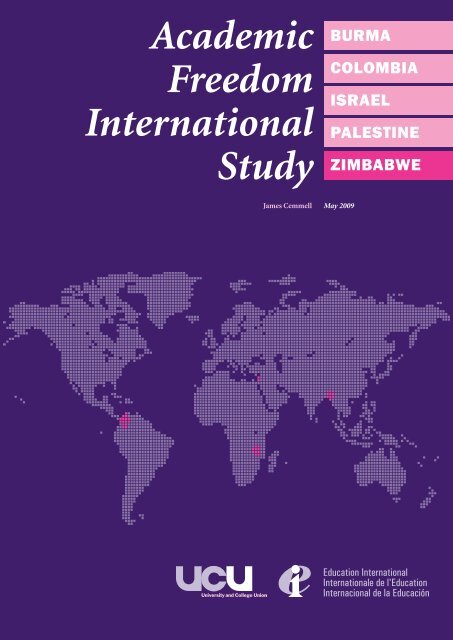
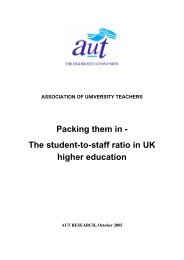
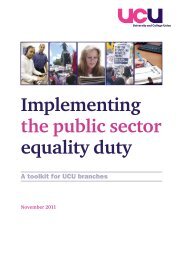
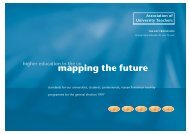
![(.pdf) [29kb] - UCU](https://img.yumpu.com/50914942/1/184x260/pdf-29kb-ucu.jpg?quality=85)
